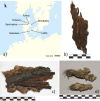Palaeoproteomics identifies beaver fur in Danish high-status Viking Age burials - direct evidence of fur trade
- PMID: 35895633
- PMCID: PMC9328512
- DOI: 10.1371/journal.pone.0270040
Palaeoproteomics identifies beaver fur in Danish high-status Viking Age burials - direct evidence of fur trade
Abstract
Fur is known from contemporary written sources to have been a key commodity in the Viking Age. Nevertheless, the fur trade has been notoriously difficult to study archaeologically as fur rarely survives in the archaeological record. In Denmark, fur finds are rare and fur in clothing has been limited to a few reports and not recorded systematically. We were therefore given access to fur from six Danish high status graves dated to the Viking Age. The fur was analysed by aDNA and palaeoproteomics methods to identify the species of origin in order to explore the Viking Age fur trade. Endogenous aDNA was not recovered, but fur proteins (keratins) were analysed by MALDI-TOF-MS and LC-MS/MS. We show that Viking Age skin clothing were often composites of several species, showing highly developed manufacturing and material knowledge. For example, fur was produced from wild animals while leather was made of domesticates. Several examples of beaver fur were identified, a species which is not native to Denmark, and therefore indicative of trade. We argue that beaver fur was a luxury commodity, limited to the elite and worn as an easily recognisable indicator of social status.
Conflict of interest statement
The authors have declared that no competing interests exist.
Figures


References
-
- Roesdahl E. The Vikings. Penguin UK; 1998.
-
- Brink S, Price N. The Viking World. Routledge; 2008.
-
- Kovalev RK. The Infrastructure of the Northern Part of the “Fur Road”Between the Middle Volga and the East During the Middle Ages”. Archivum Eurasiae Medii Aevi. 2001;11: 2000–2001.
-
- Vedeler M. Silk for the Vikings. Oxbow Books; 2014.
-
- Fadlan I. Ibn Fadlan and the Land of Darkness: Arab Travellers in the Far North. Penguin UK; 2012.
Publication types
MeSH terms
LinkOut - more resources
Full Text Sources

